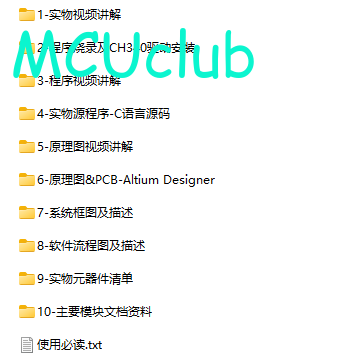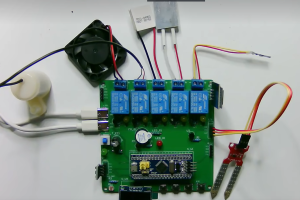项目编号:mcuclub-hj-013
STM32单片机实物设计简介:
单片机类型:STM32F103C8T6
具体功能:
1、通过DS18B20测量环境温度,超过上下限值进行加热制冷,并声光报警
2、通过土壤湿度检测模块测量土壤湿度,低于设置值进行水泵加水,并声光报警
3、通过SGP30测量CO2浓度,高于设置值进行风扇通风,并声光报警
4、通过光敏电阻测量光照强度,低于设置值进行补光,并声光报警
5、通过按键设置上下限值、手动控制加热制冷、水泵、风扇、补光、切换模式
6、通过显示屏显示数据
扩展功能:通过蓝牙模块将测量数据发送到手机端,并可以控制加热制冷、水泵、风扇、补光、切换模式
实物演示视频:
打开视频声音方法:鼠标放在视频中,点击右下角小喇叭图形即可;视频放大后不清晰,可将鼠标放在视频上,点击“进入哔哩哔哩,观看更高清”
电子版资料介绍视频:
打开视频声音方法:鼠标放在视频中,点击右下角小喇叭图形即可;视频放大后不清晰,可将鼠标放在视频上,点击“进入哔哩哔哩,观看更高清”
电子版实物资料预览

实物图
底板:底板在嘉立创进行打板,为绿色PCB板,两层板,厚度1.2,上下覆铜接地。元器件基本上为插针式,个别降压芯片会使用贴片式。
供电接口:TYPE-C

原理图
软件版本:AD2013 (本站提供该软件免费下载链接)
电路连线方式:网络标号连线方式
注意:原理图只是画出了模块的引脚图,而并不是模块的内部结构原理图

PCB图
软件版本:AD2013 (本站提供该软件免费下载链接)
PCB图是由原理图导出,封装很大一部分都是作者自己绘制,不提供封装库,只提供连接好的源文件,可以直接在嘉立创进行打板。两层板,上下覆铜接地。
注意:PCB图中间有一个项目编号,隐藏在单片机底座下,插入单片机后不会看到。如果想截没有项目编号的PCB图,可在PCB源文件中点击删除。另外,如果想在实物PCB板上加自己的信息(比如日期、学号、姓名等),可联系客服。

系统框图
绘制软件:VISIO (本站提供该软件免费下载链接)

软件设计流程
绘制软件:VISIO (本站提供该软件免费下载链接)

开题报告
下图为开题报告整体框架模板,基本上所有项目的开题报告格式都如下所示,但由于部分院校要求不一致,可能有一小部分格式有所变动。




购买后可查看具体内容!
设计说明书
总字数:18000+
摘 要
近年来,随着科技的发展,我国农业自动化水平不断提高,信息化农业越来越受到国家政策和社会各界的重视。在农业现代化的进程中,设施农业扮演着极其重要的角色。设施农业是一种采用工程技术手段对动植物生长环境进行干预,以达到高效生产目的的现代农业方式。在越来越多科学工作者的深入研究和大力推广下,设施农业已经取得了跨越式的发展。基于此背景,本文开展了针对物联网环境下的大棚远程环境监测系统的研究与设计工作,针对大棚环境种植影响主要的因素:温度、湿度、光照强度、CO2浓度进行研究和控制。本系统分为温室环境监测终端子系统、蓝牙无线传感网络及后台服务中心三个部分。本文主要成果如下:设计了以大棚环境监测终端子系统为基础单元的硬件系统,硬件部分包含环境传感器与数据采集器,两者通过无线与有线结合方式连接。环境传感器将所在监测点位的环境信息源源不断地采集发送给数据采集器,数据采集器对数据进行预处理并在LCD屏上显示,同时控制加热制冷、加湿、通风补光工作,并过蓝牙模块发送到无线传感网中,满足了温室大棚内多监测点位需要同时环境参数采集的要求;系统借助蓝牙强大的连网能力,实现区域内的温室大棚在局域网内的远程监测,将物联网技术与农业生产紧密结合。本套系统及方案适应农业现代化的要求,具有高精度、高可靠性、低成本的特点,能够满足农业温室大棚远程监测的需要,适合推广。
关键词:大棚环境;温度;湿度;CO2测控;光照强度;测控
Abstract
In recent years, with the development of science and technology, Chinese agricultural automation level is increasing, information agriculture is more and more attention by the national policy and social from all walks of life. In the course of agricultural modernization, facility agriculture plays an extremely important role. Facility agriculture is a modern agricultural way that uses engineering technology to intervene the growing environment of animals and plants to achieve efficient production. Under the in-depth research and popularization of more and more scientists, facility agriculture has achieved a leapfrog development.Based on this background, this paper carried out the research and design of remote environmental monitoring system for greenhouses in the Internet of Things environment, and studied and controlled the main factors affecting greenhouses planting: temperature, humidity, light intensity and CO2 concentration. The system is divided into three parts: greenhouse environment monitoring terminal subsystem, Bluetooth wireless sensor network and background service center. The main achievements of this paper are as follows:A hardware system based on the greenhouse environment monitoring terminal subsystem is designed. The hardware part includes environment sensor and data collector, which are connected by wireless and wired. The environmental sensor continuously collects and sends the environmental information of the monitoring point to the data collector, and the data collector preprocesses the data and displays it on the LCD screen. At the same time, the data is controlled by heating and cooling, humidification, ventilation and light replenment, and is sent to the wireless sensor network through the Bluetooth module, which meets the requirements of multiple monitoring points in the greenhouse and environmental parameter collection at the same time. The system realizes the remote monitoring of greenhouses in the local area network with the help of Bluetooth powerful networking ability, and closely combines the Internet of Things technology with agricultural production.This system and scheme meet the requirements of agricultural modernization, with high precision, high reliability, low cost characteristics, can meet the needs of agricultural greenhouse remote monitoring, suitable for promotion..
Key words:greenhouse environment; Temperature; Humidity; CO2 measurement and control; Light intensity; Measurement and control
目 录
摘 要
Abstract
第 1 章 概述
1.1 绪论
1.2 国内外温室发展现状
1.2.1 国外温室现状及发展
1.2.2 国内温室现状及发展
1.3 主要研究内容
第2章 系统方案设计
2.1 主要元器件选择
2.1.1 主控模块方案选择
2.1.2 显示模块方案选择
2.1.3 温度监测模块方案选择
2.1.4 光照强度方案选择
2.2 系统总体设计思路
第3章 硬件电路
3.1 主控模块电路
3.1.1 主控模块电路
3.1.2 晶振电路
3.1.3 复位电路
3.1.4 电源电路
3.1.5 下载电路
3.2 温度采集模块
3.3 土壤湿度监测模块
3.4 光照强度监测模块
3.5 CO2监测模块
3.6 显示模块电路
3.7 继电器模块电路
3.8 报警模块电路
3.9 蓝牙模块电路
第四章 系统程序设计
4.1 编程软件介绍
4.2 系统主流程设计
4.3 温度检测模块子流程
4.4 独立按键
4.4 OLED显示流程设计
4.5 蓝牙模块子流程
第五章 实物测试
5.1 整体实物测试
5.2 温度测控实物测试
5.3 土壤湿度实物测试
5.4 光照强度测控实物测试
5.5 CO2测控实物测试
5.6 蓝牙测控实物测试
第 六 章 结论与展望
6.1 结论
6.2 展望
致谢
参考文献
附录
附录一:原理图
附录二:PCB
附录三:主程序
购买后可查看具体内容!
答辩PPT
下图为答辩PPT整体框架模板,基本上所有项目的答辩PPT格式都如下所示,但由于部分院校要求不一致,可能有一小部分格式有所变动。










购买后可查看具体内容!

